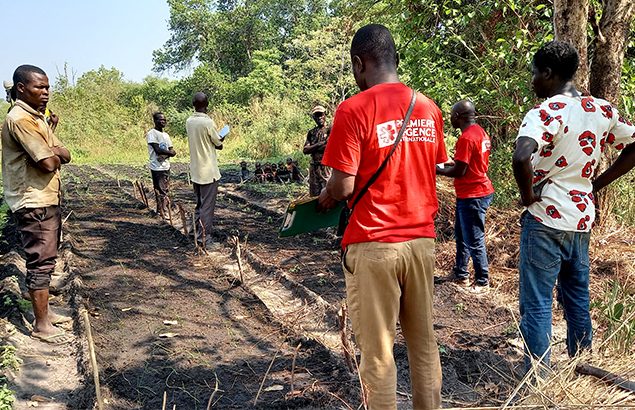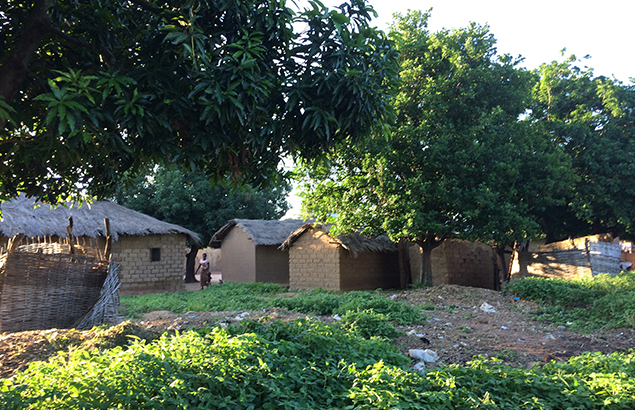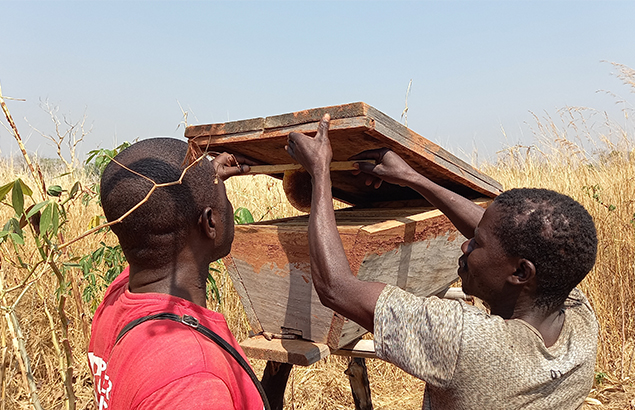Agriculture and climate change: worldwide issues
Nicolas Granmont is an engineer in international agro-development and our food and nutritional security and livelihoods referent. He discusses the consequences of climate change on agriculture and food security in humanitarian projects.

© Moïse Kotto-Feindiro | Support session for vegetable farmers, through the implementation of a farmer field school near Ndélé (Central African Republic), in March 2021
As agriculture is one of the main causes and one of the first victims of climate change, its issues are crucial in the conception and monitoring of humanitarian projects.
“We are currently working on agricultural projects in about eight countries in Asia, the Middle East and sub-Saharan Africa. These projects are mainly focused on agricultural recovery and support for the development of agricultural activities. The objective being food security and the improvement of farmers’ livelihoods, explains our referent, he adds: “In our areas of intervention, global warming can impact food security through, for example, a decrease in agricultural production and its nutritional quality. With the effects of extreme phenomena, we are facing a risk of destruction of the means of production which will have an impact on productivity and also interruptions in the agricultural supply chain which will limit access to food.”
Changes in precipitation patterns due to climate change cause, among other things, longer and more frequent droughts or floods, as well as increased temperatures that can, for example, ruin a crop or kill livestock. These changes can therefore impact the agricultural sector and consequently global food security on several levels.
“One of the first consequences of climate change, that we can observe in the field, is climatic variability, the shift in seasons, which means that the agricultural calendar is perturbed and the implementation of agricultural practices is significantly shifted“, notes Nicolas Granmont, he adds : “As a result, farmers must “juggle” this variability to conduct their agricultural activity: the more variable the seasons, the more risk of crop failure by farmers because their practices are not adapted to this variability.”
Influence on the stability of a region
Climate change can therefore have a qualitative and quantitative impact on crops. An impact on farmers’ productivity can lead to a loss of resources and influence the instability of a region. These losses can also, if they persist, lead to migration of rural communities to urban areas.
“At the level of natural resources, there is increased competition and this can be observed particularly in transhumance areas. In some countries, we are seeing an increase in conflicts between farmers and herders over access to resources, which could become scarcer due to environmental degradation and global warming,” says our referent.
As explained in our first article focused on environmental issues, the link between climate change and conflict is subtle but very real.
“Climate change will have an impact on the abundance of natural resources and therefore the competition for them. Whether real or imagined, it is the perception of scarcity that affects the risk of conflict”, says Jean Javogues our Director of Development and Innovation.

© Agnès Bouchez | Première Urgence Internationale intervenes in several countries considered to be the most vulnerable to the consequences of climate change and currently in conflict situations
Do not make the problem worse
During short-term humanitarian interventions, the method consists in trying to recover the agricultural and food situation of a territory as it was before the emergency situation occurred. This is done mainly on the basis of local resources and knowledge.
“Generally, humanitarian interventions are carried out within a short time frame. We don’t have the time to implement new practices that require time, training, resources, multiple adaptations and adjustments to be truly effective and give long-term results,” explains Nicolas Granmont. He adds: “What we can do is first: ensure that our actions do not worsen the problem and then open the field to development actions that will allow more sustainable practices. A possible solution could be the implementation of NEAT +*, which allows us to measure the environmental impacts of interventions to avoid worsening the situation afterwards.”
Although humanitarian interventions take place in contexts where the security situation is difficult, our food security and livelihoods teams generally intervene in a setting where there is a government and state services.
“Our role is therefore to support the existing framework during our interventions, in particular by strengthening the state agronomic services that will take over the situation and supervise the farmers for the development of these sustainable practices. We have to keep in mind that we are here to leave and that these services are here to stay,” adds the international agro-development engineer.

© Moïse Kotto-Feindiro | Follow-up visit to a beekeeper near Ndélé (Central African Republic), in January 2021
Building alternatives together
In addition to supporting existing services, it is essential that solutions be thought out and built with the communities.
“In the humanitarian field, we often face quite difficult contexts. It is therefore easier to change practices and approaches in systems that are more stable and where people are already food secure. What is certain is that these approaches must be built with the populations. Together we must start from what exists and add expertise and research to co-construct these responses, explains our referent: “Obviously with the most vulnerable populations, changing practices is more risky. There is an additional difficulty in implementing practices, particularly agroecological ones, in a context where food security is threatened. But involving populations and building solutions with them is a way to improve food security, while making it more sustainable.”
According to the International Federation of Red Cross and Red Crescent Societies, food security is defined by three essential factors: food availability, food access and food utilization.
A situation of food security is therefore when: “All people, at all times, have physical, social and economic access to sufficient, safe and nutritious food to meet their dietary needs and food preferences for an active and healthy life.”** (Committee on Food Security, 2009)
According to the report the “State of Food Security and Nutrition in the World“, released in July 2020***: “(…) nearly 690 million people went hungry in 2019, an increase of 10 million from 2018, and nearly 60 million in five years. Due to high costs and low affordability, billions of people are unable to eat a healthy or nutritious diet. Asia has the largest number of hunger cases in the world. Due to high costs and low affordability, billions of people are unable to eat a healthy or nutritious diet. Asia has the largest number of hungry people, but Africa has the fastest growing number.”**

© Agnès Bouchez | According to United Nations estimates, food insecurity still affects more than 800 million people in the world today
A future that is being played out now
The issue of agriculture and climate change is intertwined with global food sovereignty and will therefore be central to discussions related to climate adaptation and resilience.
“Global warming impacts our activities, because we are going to intervene in crises that are caused by the consequences of global warming. We will also be affected by them during our agricultural projects,” insists Nicolas Granmont.
Since 2020, the Première Urgence Internationale teams have created an Environment Task Force within the organization. Through meetings, training, actions and exchanges of ideas, the teams are working to reduce their environmental impact, whether at the NGO’s headquarters or in the field.
The environment and climate change are thus an integral part of the NGO’s 2021 strategy.
For more information on Première Urgence Internationale’s actions in favour of the environment, keep an eye on the news and on our networks or subscribe to our newsletter.
Read again our first article focused on the environment.
* NEAT+ is a tool for assessing the environmental impacts of humanitarian projects that allows for the inclusion of climate and environmental risks in the design and management of projects in order to adapt them to future conditions.
** Originally in French.
*** Jointly by the Food and Agriculture Organization of the United Nations (FAO), the International Fund for Agricultural Development (IFAD), the United Nations Children’s Fund (UNICEF), the World Food Programme (WFP) and the World Health Organization (WHO).
